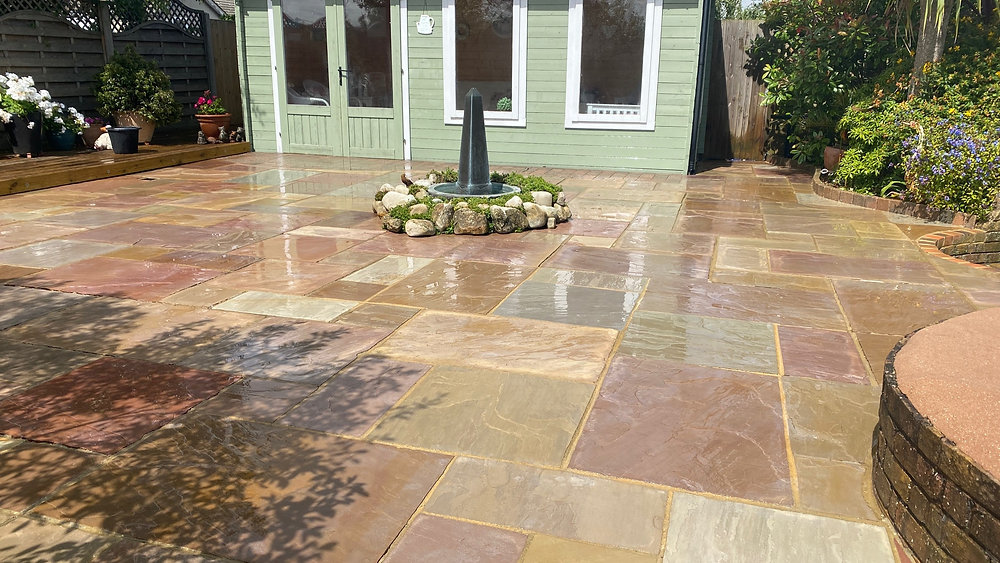How to Clean Your Paving and Patios: A Step-by-Step Guide
Paving and patios are inseparable components of any home, and working with an experienced patio installers ensures your outdoor space is both functional and aesthetically pleasing. The key element to remember is that an impressive patio should look clean, brand-new and with zero imperfections. Regarding the beauty part, pavers are among the favourite options to give a specific look to driveways, yard walkways and even patios. Unfortunately, patios and paving over time will appear dirty and lose their appearance and are selected less often for cleaning.
Preventative regular maintenance saves you properly against harmful elements and keeps your patios and pavements looking great. Here we will discuss how to clean your paving and patios so that you can easily maintain your outdoor space.
Why Maintain Your Paving And Patios Regularly
- Improve appearance:
Immaculate pavers can dramatically enhance the visuals of your outdoor area. Over time, dirt, grime, and organic growth like moss and algae can accumulate on the surface, lessening the aesthetic of your outdoor area. Regular cleaning and maintenance of the paving and patio make your backyard more appealing to you as well as guests coming over.
- Prevents Weed Growth:
When not cleaned and maintained regularly, weeds can grow in between the joints of your pavers. Weeds make your pavers look ugly and, in turn, cause damage to them as well. Regular cleaning helps remove weed seeds and prevents them from growing, maintaining the structural integrity of your paver.
- Expand Longevity:
If a patio isn't cared for, it could soon be under attack from the scum of moss, algae and other regular damage. These pollutants leave cracks on the surface, eventually turning into unsightly stains or deep discoloured spots. The effect is severely shortened on your investment. Monitor your patio and keep it dirt-free; it'll render these poisonous elements powerless. This will mean longer life and more enjoyable use for years to come.
- Improves safety:
Your patio could easily turn into a hazardous criss-cross of gutters in damp weather. The growths of moss, algae, and other substances on its surfaces are another kind altogether: that makes walkways slippery with dew-bearing humidity, which can lead to nasty accidents. From regular cleaning, you can be sure it won't slip; in this way, your sidewalk or patio will be a safe place to walk and move.
How to Get Ready To Clean Your Paving and Patios?
Assess the area:
Cleaning your patio pavers effectively means understanding the different kinds of pavers that are in your outdoor space. Each has its unique characteristics and maintenance methods that are best for it to keep up appearances and durability.
- Brick Pavers: With their classic good looks, brick pavers are particularly prone to moss and mildew, especially if they get damp. Proper cleaning should help them keep their appeal.
- Concrete Pavers: These durable, adaptable pavers are well-suited for patios, but will discolour unless regularly cleaned of dust, mould, and grime binding onto joints between the pieces.
- Natural Stone Pavers: With an air of exquisite luxury about them, natural stone pavers are prone to stains from organic materials like leaves and fruits. They need careful cleaning to maintain their charm.
Identify types of stains:
First and foremost, when can you say that a paver is clean enough? Given that pavers are continuously exposed to risks of being stained due to organic debris, oil spills, and weather conditions like heat and humidity, leaving your patio pavers unwashed can result in an unimpressive sight. On the other hand, knowing what kind of stains your patio pavers are suffering from is crucial for selecting the most effective cleaning method.
- Organic Stains: The first kind of stains that can appear on your patio pavers is organic. Such stains can occur when leaves, berries, or other plant materials are left on the pavers and start decomposing. In addition, dust swept together with the organic debris will eventually make an unsightly mark. To avoid such stains, the pavers have to be regularly swept and cleaned.
- Oil Stains: Regardless of whether or not the oil comes from food or your car’s engine, they are very hard to wash off. As a rule, the oil etches the surface of the paver and becomes a permanent or almost permanent stain. Thus, acting quickly and selecting the appropriate cleaning agent is a must for getting rid of the smell of gasoline from the patio pavers.
- Mould and Mildew: Even though this kind of “dirt” does not seem to affect the pavers in any way, the ugly carpet of green and white spots will simply ruin the impression that your patio creates. As the saying goes, the entire chain is only as strong as its weakest link. In your case, the mould and mildew on the surface of the pavers are the weakest links.
Gathering cleaning supplies:
At the very start, before attempting to clean your patio pavers, it would be reasonable to have all the necessary cleaning supplies.
- A stiff-bristled broom or a brush could work greatly for removing loose dirt, leaves, and other debris from the surface of the pavers.
- To rinse off, a garden hose with a spray attachment would be a beneficial tool.
- For a more thorough cleaning process, a bucket, some mild detergent, and a scrub brush or a pressure washer might also come in handy.
- If you have some specific stains, like oil or rust, it would be beneficial to have a certain stain remover or degreaser at hand.
- After cleaning your patio pavers, do not forget about the sealant that will help protect the surface from future stains and weather exposure.
With all of these supplies available, you will be all geared up for the cleaning process in terms of both time and resources.
Knowing safety measures and protective gear:
If you wish to start, make sure that you consider safety first. For this purpose, have the following protection means: gloves to protect your hands from solutions and dirt; safety goggles to prevent splashes and fumes from getting into your eyes; a mask to keep your lungs safe from particles and potentially dangerous fumes if you want to clean with chemicals.
How to Clean Your Paving and Patios?
1. Sweeping and Rinsing:
In the beginning, most of the dirt should be swept. Thus, grab a broom with stiff bristles and collect all leaves, dirt and sand left on the surface. Then rinse the pavers with a garden hose to wash all other dirt away and prepare them for further cleaning. By starting with sweeping and rinsing, you ensure that the pavers are free of loose particles before proceeding with further cleaning methods.
2. Addressing Stubborn Stains:
- Remove Weeds and Moss: A mixture of white wine vinegar and water works extremely well to kill that brutal weed growth within your patio paver. All you have to do is put this mixture on the affected part and leave it for 30 minutes. Then use a tough brush to scrub away the weeds and moss. Apart from eliminating unwelcome plants, regrowth is also restricted by daisy, while you remain assured that no harmful substances are included to harm your outdoor space.
- Oil Stain Removal Tricks: If oil has spilled on your patio pavers, simply mix baking soda and water can remove it from regular use. Sprinkle baking soda over the oil-stained section in a decent amount, and now pour some water on it to make a paste of sorts. Use a brush or cloth to lightly scrub the paste into the stains. Leave it for an hour, and after this, wash it off with plain water. It is safe, environmentally friendly and will clean even the toughest oil stains you may have on your pavers.
- Rust and Other Mineral Stains Removal: For rust and mineral stains on your patio pavers, use lemon juice or white vinegar. The acidity in such substances helps break down the stains without being harsh on the pavers. Spritz or mop some lemon juice on the mouldy spots, wait 10-15 minutes and then scrub with a brush and rinse. This method is gentle but effective in removing ugly rust and mineral stains from outdoor surfaces.
3. Pressure washing:
To get the best results from a pressure washer, you need a basic understanding of how they work and what settings are appropriate for your application, as well as some safety precautions.
How to Use a Pressure Washer Correctly:
- Read The Manual: Always read the owner/manufacturer instructions for your model.
- Protect your skin: Safety goggles, gloves, and non-slip footwear are a must. Ear protection is recommended for pressure washers that are very loud.
- Hook up the hose: Connect a garden hose to your pressure washer and screw it into place so that it's water-tight.
- Attach the Nozzle: Once you select a nozzle, connect it to your spray wand.
- Test the Gas/Oil: Make sure to fill up your pressure washer with oil and sufficient fuel.
Technique:
- Grip the Wand: Hold onto both sides of the wand to keep it secure.
- Open the Faucet: Open your faucet before cranking the gear (gas) or turning on the equipment work.
- Move the Nozzle in a Sweeping Motion: Make sure to keep the nozzle at an even distance from your surface and use sweeping strokes. Do not let it sit for too long in one spot to avoid ruining the surface.
- Crossover Passes: Make sure that your passes are overlapping even a little bit; this will help you get good coverage of the logs and no streaks.
Pressure Settings on Different Materials:
- Concrete: 2500-3000 PSI, 15-25 degrees nozzle
- Wood: 1200-1500 PSI, 25-40 degree nozzle
- Vinyl Siding: 1500 to 2000 PSI, 25- 40 degree nozzle
- Brick/Stone: 2000-3000 PSI, 15-25 degree nozzle
Safety precautions while using a pressure washer:
- Test on Small Area: Use a test to ensure no damage is caused by the power of agitation if you use any pressure at all.
- Keep Distance: The nozzle must be 6-12 inches away from the surface.
- Use Proper Nozzle: The nozzle you need is dependent on the spray pattern that it provides. Select the one that fits the work and material.
- Do Not Spray Directly onto Electrical Ports or Appliances: Water and electrical components do not mix well, causing short circuits and damage
- Do Not Use Pressure Washers On Soft Surfaces: Do not pump too much volume and high pressure on materials such as wood, stucco, or painted surfaces without full experience.
- Observe Manufacturer’s Instructions: Stick with the pressure settings and cleaning solutions recommended by the manufacturer of your model.
4. Manual Scrubbing:
Select a concrete cleaner that is tailored to the particular type of stain you have.
- Apply cleaner - Spray the patio cleaner evenly all over your patio, paying particular attention to any areas with staining.
- Scrub the surface - Apply a stiff-bristled or deck brush to agitate cleaner into the concrete. If stains are a bit more stubborn, you will need to apply some extra elbow grease.
5. Rinsing:
Spraying the entire patio down with water first will help loosen dirt and debris. You rinse from top to bottom so that the dirty water does not run over other cleaned areas. Inspect the surface for cleaner/debris. If you see any leftover cleaner or debris, be sure to rinse it away.
Natural and Eco-Friendly Solutions For Patios And Pavers
Natural cleaning solutions are a popular answer for how to clean your pavers without a power washer, and they help in keeping the environment green. This is the way that you can use for easy cleaning of your outdoor surfaces without chemical and high-pressure equipment.
Using Vinegar and Water:
Most people have vinegar in their homes, and it can be used to clean your pavers super easily. Fill a spray bottle with white vinegar and water in roughly equal proportions. Generously spray the solution over your pavers and allow it to sit for a few minutes. Next, clean the area by brushing away any dirt, moss or unsightly stains. Then rinse the pavers off with your hose to expose their new appearance.
The Role of Baking Soda:
One more organic ingredient that can effectively clean your pavers is baking soda. Baking soda is mixed with water to create a thick consistency and form a paste. Dab the paste onto stains or soiled spots on your pavers and allow it to stay there for approximately 15-20 minutes. Next, use a brush to rub the paste into the dirt. Lastly, wash the pavers with water to complete your cleaning process.
Soap and water mixture:
A soap and water mixture can be used for gentle cleaning for regular maintenance of the patio and pavers. Combine with water a small amount of mild dish soap or a specific paver cleaner. Now, with a scrub brush, simply work it into the pavers where you have stained them. Concentrate on scrubbing until you can clean the stains, and after that, clear out your pavers entirely with clean water.
Boiling water:
Boiling water also has a simple and natural cleaning process for removing the moss from your patio. This helps kill the moss outright by scalding it with boiling water that loosens its grip on surfaces close to the ground. All you need is boiling water, which, as it happens, most people already have at home and costs virtually nothing.
Steps to clean the moss from concrete with boiling water:
- Fill a large pot or kettle with water and bring it to a boil
- Gently pour the boiling water over the mossy area, being sure to coat all of it.
- Just wait a couple of minutes till the moss goes brown and shrivelled.
- Use a stiff-bristled brush to scrub away the moss and water.
- Rinse the area with water to remove any film.
Preventative Maintenance Tips For Paving and Patios
1. Sealing Paving and Patios:
Benefits:
- Sealants can help protect slate from water damage, stains and UV rays that may deteriorate over time.
- By applying a sealant, you can improve the colour and overall look of your pavement or patio to keep it looking newer and longer.
Application Tips:
- Clean the surface before sealing it. The area should be uncontaminated and dry for best results.
- Choose the right type of sealants based on concrete, brick or stone.
- Evenly roll or spray down the sealer. Do not puddle or overapply.
- Adhere to the manufacturer's instructions
- The standard lifespan of most sealants is to have them reapplied every 1-3 years, but this will vary based on the type and condition.
2. Regular Sweeping and Rinsing
Benefits:
- Regular sweeping and rinsing at least once a week will prevent debris, leaves and dirt build-up that can lead to staining or surface deterioration.
- Regular cleaning of surfaces reduces the likelihood that accumulated dirt or algae will lead to slipping and falling.
How to Best Sweep and Rinse
- Sweep Often: Try sweeping with a broom to clean off your paving stones and patio at least once per week.
- Regular Rinsing: Rinse down the surface with a hose or pressure washer to get rid of loose dirt and decrease grime accumulation.
3. Weed Control:
- Proper Installation: Ensure that interlocking paving stones or patio tiles are installed with proper joint spacing and a suitable base to reduce the incidence of weeds.
- Pull: Manual (Hand pull; use a weeding tool to remove weeds in the joints and cracks). Repeat this regularly so that deep roots do not form. Add more sunlight and use the right moss killers, and it will control moss.
- Weed Killers: If you have a particularly nasty weed problem, choose the appropriate herbicide. For best results and to prevent damage to your paving and the surrounding beneficial plants nearby, ensure you follow the safety instructions. Pay additional attention to how this product is applied.
- Vinegar: A solution of vinegar and water works as an organic weed killer for smaller sections. Take care, though, as the vinegar can also damage nearby plants.
Conclusion
To keep paving and patio surfaces looking their best and working, you should regularly clean and maintain them. To keep debris from building up and eventually staining the surface or causing damage, sweeping or a good rinsing periodically is important. Sealants are crucial to protecting your surfaces and maintaining their life because they prevent exterior elements like oil, stains, and weed growth from penetrating the top surface of any hardscape area.
Prevention of weeds and moss is integral to a cleaner, more beautiful yard. By upholding a regular patio and paving cleaning routine, you are not just keeping your pavers looking good, but prolonging their life. By adhering to detailed patio and paving maintenance procedures, you experience an up-to-date outdoor living space that remains usable and coordinated for years down the line.










